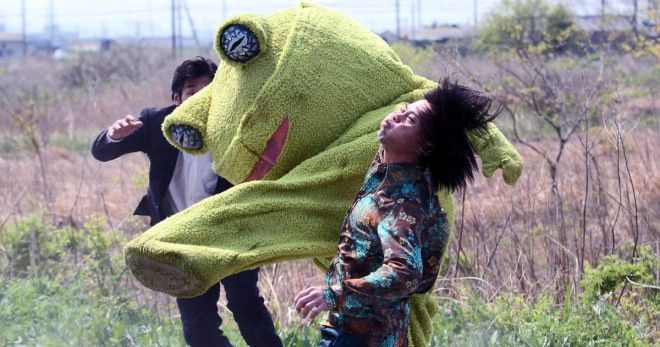Yakuza Apocalypse (Miike Takashi, 2015)

Playing this Friday and Saturday at midnight only comes the latest from prolific Japanese lunatic Miike Takashi. The limited late night time slot gives a hint of what to expect, even if you’re unfamiliar with Miike’s work, much of which amounts to highly imaginative reworkings of familiar genres, pushing them to their extreme (and often extremely violent) conclusions. But while the Miike review that doesn’t contain the word “gonzo” is a rarity, he is no scattershot shock auteur. His films, unpredictable as they may be, are always guided by a clever intelligence. He’s not a director of chaos, but of logical absurdity. Of the more than 40 films he’s directed this century, I’ve only seen a handful, but Yakuza Apocalypse is firmly in the tradition of earlier films like Sukiyaki Western Django, 13 Assassins, and his remake of the Kobayashi Masaki classic Harakiri in their critique of the psychotic masculinity that underlies the ideology of traditional Japanese action narratives. Of course, critiquing the samurai code has been an essential part of the samurai/yakuza genres in cinema since at least the end of World War II. But Kobayashi, Okamoto Kihachi, and Kurosawa Akira, as far as I know at least, never made a film about gangster vampires fighting demons in plushy cosplay frog outfits.
Yakuza Apocalypse begins with a scene that might have been modeled on the climax of a Chang Cheh film like 1970’s Vengeance!: a man of violence fighting his way through a army of fellow criminals, slicing up bad guys while suffering almost as much damage himself. In the climactic moment, he’s shot multiple times but, with a final lunge, dispatches his ultimate enemy. In a Chang movie, this hero would then die at the moment of his triumph, frozen, his sacrifice in the name of honor and righteousness made tangible by the fact that he never falls down–he dies standing up. Miike’s hero though doesn’t die. Or rather, he’s already dead: he stumbles home, meets his girlfriend, and drinks her blood. The hero Kamiyura (played by Lily Franky) is a vampire. Following scenes establish him as a pillar of the community, idolized by a young yakuza named Kageyama (Ichihara Hayata), defending the weak and spreading his criminal wealth to the desperately poor while keeping his undead nature hidden from his associates. But when he is suddenly set upon by supernatural assailants (one dressed like a 17th century missionary, the other played by Yayan Ruhian, the long-haired Indonesian badass from The Raid: Redemption and its sequel), he’s passes on his vampire powers to Kageyama.
Being a new vampire, Kageyama doesn’t know the rules and quickly spreads his condition through the population. The one rule is to only feed off yakuza, not the general population. It’s eventually explained to him and us that in this way the criminals and the normal citizens are able to stay in balance. But Kageyama’s foolishness throws off that balance, turning the citizenry into vampires and throwing the whole economy out of whack. Yakuza are killed left and right as the suddenly empowered citizens start feeding and spreading their pandemic, the division between labor and power disintegrating as labor takes all the power and no one bothers to work anymore. Of the remaining yakuza leadership, one goes insane, dreaming of planting humans she can raise (a charmingly cartoonish image of benevolent fascism), while another joins up with the vampire hunters, who are themselves joined by a pair of demons: one a turtle-backed and -beaked Kappa demon, the other the aforementioned frog monster called the “Modern Monster” (I don’t know if it’s as based in Japanese folklore as the Kappa is, but if it isn’t it probably should be).
With everyone sorted into factions and society descending into chaos, the stage is set for a series of battles, each of which Miike shoots with precision and assured staging. The choreography isn’t especially creative, rather emphasizing the physical impacts of various blows over the athletic skills of the performers. Ruhian stands-out in these brutal and-to-hand combat scenes, of course, but Ichihara holds his own, not as flamboyantly skilled but nonetheless showing a dogged, long-limbed resilience. The bluntness of the yakuza-vampire parallel, of the lunacy of a parasite devouring its host, is topped by one of the final fights, as two men simply stand in front of each other, hands crossed as they slowly build up strength and, with a mighty roar, punch each other in the head. They stagger back, regain their balance, line up and punch each other again. This goes on long enough to make its point, becomes a bit tedious, and eventually becomes hilarious, like the martial arts version of the famous Simpsons rake gag. Despite all the goofy mythology and flights of fancy, the folklore and the costumes and the political allegories, it all (genre, myth, ego, action cinema, life) really boils down to one man being just mean enough to punch someone in the head, and just dumb enough to stand up and get punched himself.
